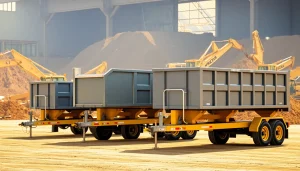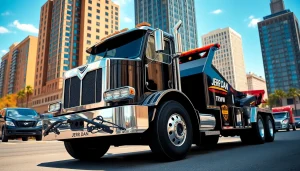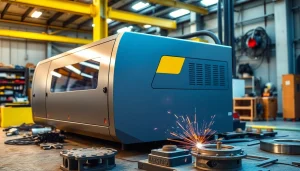Introduction to Precision Die Cutting
Precision die cutting is an essential manufacturing process that enables the production of intricate and accurate shapes from a range of materials. As industries continue to refine their production processes, the demand for precision die cutting has surged, providing businesses with the capability to create effective solutions faster and more cost-effectively. This complex technique plays a pivotal role in various sectors, from automotive to packaging, medical devices, and consumer goods. It involves the use of custom-made dies to slice through various substrates, ensuring precision and reliability. Precision die cutting not only optimizes production but also enhances the quality of finished products.
What is Precision Die Cutting?
Precision die cutting refers to the process of using specialized tools (dies) to cut materials into precise shapes and sizes. These dies can be made from various materials, such as steel or sharp blades, and can cut through paper, cardboard, plastic, fabric, and metal. The main distinguishing feature of precision die cutting over traditional methods is its ability to maintain exact tolerances, critical for applications requiring high levels of accuracy, such as electronic components and surgical instruments.
The die cutting process can be executed via several methods, including flatbed, rotary, and laser cutting. Each method offers unique advantages depending on the application, volume, and type of material being used.
The Importance of Precision in Manufacturing
In manufacturing, precision is not merely a luxury but a necessity. High precision in die cutting significantly dictates the functionality of the final product. For instance, in the aerospace and automotive industries, even minor inaccuracies can lead to product failure, safety hazards, and costly recalls. Precision die cutting helps manufacturers adhere to strict tolerances, ensuring components fit seamlessly into the final assembly, which ultimately enhances product reliability and performance.
Additionally, precise die cutting can lead to reduced material wastage, as it allows for more effective layout optimization. With every inch of material accounted for, companies can save costs and reduce their ecological footprint.
Industry Applications of Precision Die Cutting
The versatility and precision of die cutting have made it invaluable across various industries:
- Automotive: Die cutting is used for making gaskets, seals, insulation, and sound-deadening materials that are critical for vehicle performance.
- Medical: In the healthcare sector, precision die cutting is utilized to manufacture surgical instruments and medical devices that require meticulous detail and compliance with regulatory standards.
- Packaging: Die cutting is essential for producing custom packaging solutions that enhance product presentation while also providing protection.
- Electronics: The production of circuit boards and electronic housings relies heavily on precision die cuts for accurate and reliable components.
- Textiles: Fashion and upholstery industries use die cutting to create complex patterns and ease the manufacturing process.
Types of Precision Die Cutting Techniques
Flatbed vs. Rotary Die Cutting Methods
Understanding the distinctions between flatbed and rotary die cutting methods is crucial for manufacturers to select the most effective technique for their needs.
Flatbed Die Cutting
Flatbed die cutting involves placing material on a flat surface, where a blade die descends to cut the material into the desired shape. This method typically features a more straightforward setup, making it ideal for short runs and projects requiring multiple cuts of a single configuration. However, while it can effectively handle a variety of materials, it may not achieve the same speed or efficiency as rotary die cutting.
Rotary Die Cutting
Rotary die cutting employs a cylindrical die that continuously rolls over the material, cutting shapes as it moves. This technique is usually faster and more efficient for high-volume production runs, facilitating quick changeovers between different designs. It is especially beneficial for items like labels and packaging materials that require speed and consistency.
Advanced Automated Die Cutting Solutions
As technology continues to advance, automatic die cutting solutions have emerged, incorporating features such as digital automation, computer control, and real-time monitoring. These systems significantly enhance precision, reduce human error, and enable rapid prototyping. Automated die cutting machines can adjust for tolerances in real-time, ensuring that each cut is exactly as specified, which is paramount in sectors where precision matters most.
Modern machines also facilitate the integration of various finishing options, allowing manufacturers to produce complex designs that include embossing, debossing, and other interactive features.
Comparing Die Cutting Techniques in Various Sectors
Across different sectors, the choice of die cutting technique often hinges on the specific requirements of the application. For example, the medical sector may lean towards flatbed die cutting due to its versatility while producing small batches of complex designs, while high-speed rotary systems might dominate consumer packaging for their efficiency. The significance of selecting the right method cannot be overstated, as it can impact production schedules, costs, and ultimately, product quality.
Benefits of Choosing Precision Die Cutting
Cost Efficiency and Producing High-Quality Parts
One of the primary advantages of precision die cutting is cost efficiency. By utilizing specialized dies tailored for specific applications, manufacturers can produce high-quality parts with minimal waste. The initial setup costs may be higher than traditional cutting methods, but the long-term savings derived from reduced material waste and higher production rates often make it a more economical choice.
Moreover, the precision of this method ensures that parts meet high quality standards, which is particularly important for industries that require strict compliance with safety and performance regulations.
Speed and Scalability in Production
Precision die cutting is not just about quality; it’s also about speed. With the right technology, high-volume orders can be produced faster than with conventional methods. For manufacturers dealing with fluctuating demand, the scalability of die cutting allows for quick adjustments in production schedules, ensuring that they can meet customer demand without compromising on quality or delivery time.
This capability is valuable in industries like packaging, which may experience spikes in demand based on seasonal variations or promotional cycles.
Material Versatility in Precision Die Cutting
Another significant benefit of precision die cutting is its versatility concerning materials. Manufacturers can cut a wide range of substrates, including but not limited to, paper, plastics, rubber, foam, and metals. This flexibility allows companies in various industries to innovate without the constraint of material limitations. By sourcing different materials, they can achieve diverse attributes in their products, including weight reduction, enhanced durability, and improved aesthetic appeal.
Challenges and Solutions in Precision Die Cutting
Common Issues Faced in the Die Cutting Process
Though precision die cutting offers numerous benefits, several challenges can arise during the process. One of the main issues is the wear and tear of dies, which can affect the consistency of cuts. Regular maintenance and inspection of tools are essential to ensure that they remain sharp and effective over time.
Material selection can also present challenges, as different materials may behave unpredictably under cutting pressure. Understanding material properties and conducting pre-production tests can help mitigate this risk.
Ensuring Tolerances and Quality Control
Quality control is paramount in the die cutting process. Manufacturers need to implement rigorous testing protocols to ensure that cuts meet specified tolerances. This can be achieved through a combination of manual inspections and automated measuring systems, which can evaluate part dimensions and integrity in real-time.
Additionally, employing statistical process control (SPC) techniques can help in monitoring and maintaining consistent quality across production runs.
Technological Innovations Improving Precision
The introduction of artificial intelligence and machine learning into precision die cutting offers exciting possibilities for enhancing accuracy and efficiency. These technologies enable predictive maintenance for machinery, reducing downtime and associated costs. Furthermore, advancements in material sciences are leading to new substrates that can be cut more easily or provide enhanced performance characteristics.
3D printing technologies also complement traditional die cutting by allowing for the easy prototyping of intricate designs that can later be manufactured in bulk using die cutting techniques.
Future Trends in Precision Die Cutting
Emerging Technologies in the Die Cutting Industry
The die cutting industry is rapidly evolving, with new technologies continuously emerging. Developments in automation and robotics are leading to more efficient machinery capable of producing complex designs without human intervention. Additionally, innovations in material handling systems are streamlining workflows and reducing lead times.
Green technologies are also becoming integrated into die cutting processes, with companies looking for ways to lower their environmental impact and ensure sustainability. This includes recycling scrap materials from die cutting processes and utilizing eco-friendly substrates.
Adapting to Market Needs with Precision Die Cutting
To remain competitive, manufacturers must be agile and responsive to market demands. This means employing precision die cutting not only for traditional applications but also for developing new products that meet contemporary consumer preferences. For instance, the demand for customized packaging solutions has risen dramatically, calling for manufacturers to employ precision die cutting to achieve unique designs that stand out on shelves.
This ability to innovate quickly in response to shifting market landscapes will likely distinguish successful companies from their competitors.
The Role of Sustainability in Precision Die Cutting
As the world becomes increasingly aware of environmental concerns, manufacturers face pressure to embody sustainability in their operations. Precision die cutting can align with these efforts by using less material and producing less waste than traditional methods. Further, the adoption of biodegradable and recyclable materials can elevate the sustainability profile of products manufactured through precision die cutting.
In summary, embracing sustainable practices in precision die cutting not only benefits the environment but can also resonate with consumers who seek to support eco-friendly initiatives.





